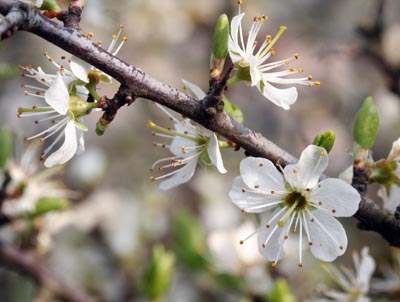Butterflies are hatching, and as soon as they emerge they seem to be concentrating on the next generation just as quickly as they can. This shot shows a pair of Green-Veined Whites: male at the top of the picture, female at the bottom:
 |
| Pair of Green-Veined White butterfly |
At the moment, the male Orange Tips are still patrolling, looking for the females:
 |
| Male Orange Tip butterfly |
I think the underside of the Orange Tip is quite beautiful (as well as being good camouflage):
 |
| Male Orange Tip - underside |
Small Tortoiseshells are looking very threadbare now: they overwinter as adults and the wings have lost most of their scales.
 |
| Small Tortoiseshell butterfly |
I was watching another of the cuckoo Bumblebees - Bombus bohemicus - and managed to get a clear shot of one of the identification features. Since these bees don't collect pollen for themselves, they have no use for pollen baskets:
 |
| Cuckoo Bumblebee - Bombus bohemicus |
Solitary bees make their own nests, with the female collecting pollen to feed her own brood. Solitary bees are usually either mining bees (make tunnels in soil) or mason bees (make tunnels in soft stone or mortar). It should come as no surprise that there are bees which are parasitic on solitary bees, and there are a few species of Nomada which are kleptoparasitic on solitary bees - they steal the pollen from the tunnels. This appears to be Nomada leucopthalma, a kleptoparasite of Andrena clarkiella, which is just coming to the end of its season (they collect only willow pollen). So Nomada leucopthalma will be coming to the end of its season, too:
 |
| Nomada leucopthalma |
A few more flowers opened today:
Bush Vetch:
 |
| Bush Vetch |
 |
| Common Fumitory |
 |
| Blackthorn Flowers |
April 28th is St. Mark's day, and the Bibio genus of flies appears on or around that date, so they are commonly known as St. Marks Flies. With this being such an early year, they are a couple of weeks earlier than usual:
 |
| Male St. Marks Fly |
Tomorrow I'm off to a limestone area, so I should find something interesting there.

3 comments:
Like others, I learn so much from your blog, Stuart.
We had a small yellow ?moth in our house yesterday, but by the time I got my camera, it had flown out ... so am just off to try to ID it from memory (not dissimilar to a small Brimstone butterfly).
We have more blossom on our blackthorn than the farmer can ever remember, Stuart. And judging by the buds the same is going to be true of both crab apple and hawthorn.
Caroline, there's a good chance you saw the Brimstone Moth. It's bright yellow, and should just be emerging now. It's a feeder on Hawthorn and Blackthorn.
Weaver, yes: anything that flowers appears to be having a very good year. Yesterday I passed a row of Blackthorn and a single specimen of Hawthorn was already in bloom. Quite a year so far.
Post a Comment